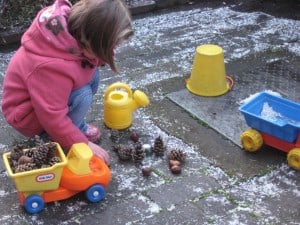The A – Z of Kids Play & Learning
A is for…. Active Learning
I once sat in on a pre-school session where the teacher was introducing a group of eight 3-year-olds to the idea of mixing colours. She had two pots of paint, one red and one yellow, and was showing the children how combining the two would make orange. Messy fun, sensory play swirling the colours together, and the magical realisation that they’re created something new by stirring the colours together. Except the children weren’t allowed to touch the paint themselves. They were being asked to sit around a table and watch the teacher having all the fun. What a missed opportunity to let the children do some active learning.
Active learning means learning by doing – by exploring and investigating, being spontaneous and engaging in purposeful play. It’s the way children learn best. They are naturally curious and inquisative, so rather than see our job as giving children information we can look for ways to help them learn and discover for themselves. No hot-housing, no flash cards, no sitting still and being taught, but rather using their everyday experiences to learn: at the breakfast table, in the bath, in the garden, on the way to play group. By letting children persue their interests with our support, they gain a positive attitude to learning. They enjoy learning, they gain confidence and independence and they aquire new skills.
Here are three ideas you could use this week to support your children in their active learning:
1. Materials: Can you provide some materials, toys or objects which are ‘open-ended’ so you child can use them in a variety of different ways in their play? How will you child play with some wooden blocks, yoghurt pots, fir cones or shells? Let them use their creativity and see where their imagination takes them.
2. Freedom: Can you let your children choose how to play this week? Are they able to access different toys / materials to include in their play — perhaps by having it on low, open shelving or in toy boxes, so they can include different objects in their games? Can they have ‘permission’ to play their way, taking toys in to the garden, using jigsaw pieces as food in their ‘cooking’ or wearing a tambourine as a hat? Can they spend the whole morning rolling a ball down a slide (and experimenting with gravity and rotation as they play?)
3. Support: Can you play along with them and talk to them about what they’re doing? Can you help them solve problems when they meet an obstacle to their play? Can you plan another opportunity for them to explore their interests further?
As an example of active learning, taking a child’s interest and supporting it to provide more fun and learning you might like to have a look at our ‘Ducks’ post.
What could you play this week?

